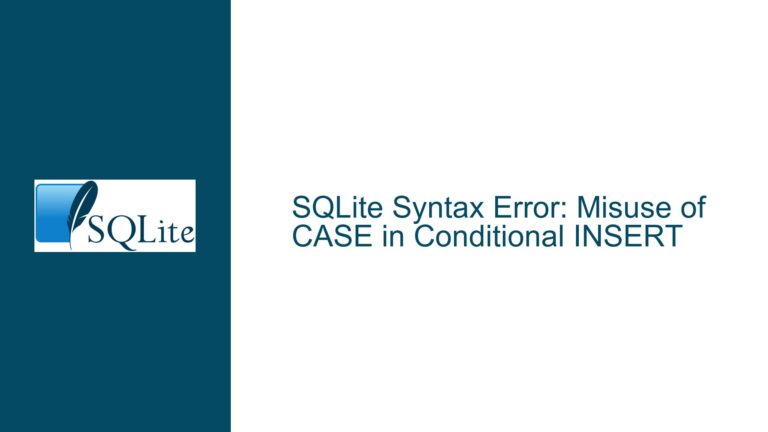Efficient Text Search in SQLite: Word Combinations and Order Optimization
Understanding the Challenge of Searching for Word Combinations in SQLite
When dealing with text search in SQLite, especially when the goal is to find specific word combinations within strings of text, the challenge lies in balancing efficiency, accuracy, and the complexity of the search logic. The primary issue revolves around searching for a variable number of specific words that occur in any order within a text column, and then returning the results in a specific order: first, verses where the words appear in the exact order specified; second, verses where the words appear sequentially but in any order; and finally, the rest of the verses that contain the words, ordered by book_no, chapter_no, and verse_no.
The text column in question ranges from 11 to 556 characters, which, while not excessively large, can still pose performance challenges if not handled correctly. The core of the problem is to avoid scanning every row of the table for each search request, which would be highly inefficient, especially as the dataset grows. The question then becomes: what is the most efficient way to structure the data and the queries to achieve the desired results?
Exploring the Feasibility of a Concordance Table vs. Full Text Search
One proposed solution is to build a concordance table, which would essentially be an index of every unique word across all texts, along with their positions (i.e., book_no, chapter_no, verse_no, and word_no). This approach would allow for efficient lookups of word combinations by examining the intersections of these positions. However, this method introduces its own set of challenges, such as handling punctuation, italicized words, and other formatting issues that may affect the accuracy of the search.
Another approach is to leverage SQLite’s Full Text Search (FTS) extension, which is designed specifically for efficient text searching. FTS can handle many of the complexities of text search, including punctuation and formatting, automatically. However, FTS is typically more suited for content that changes frequently, and there may be concerns about its performance and suitability for static content, especially when the goal is to search for specific word combinations and orderings.
Implementing a Hybrid Approach: Combining Concordance and Full Text Search
Given the strengths and weaknesses of both approaches, a hybrid solution might be the most effective. This would involve using a concordance table for the initial word lookup, combined with FTS for handling the complexities of text formatting and punctuation. The concordance table would provide the necessary structure for efficient word combination searches, while FTS would ensure that the search is robust and accurate, even in the presence of formatting variations.
To implement this hybrid approach, the first step would be to create the concordance table. This table would have one row for each unique word in the text, along with its position (book_no, chapter_no, verse_no, and word_no). This table would be populated by parsing the text column of the original table, splitting the text into individual words, and recording their positions. This process would need to handle punctuation and formatting, possibly by preprocessing the text to remove or standardize these elements.
Once the concordance table is in place, the next step would be to create an FTS virtual table that mirrors the original text table. This FTS table would be used to handle the actual text search, leveraging its built-in capabilities for handling punctuation and formatting. The FTS table would be populated with the same text data as the original table, but with the added benefit of FTS’s advanced search capabilities.
With both the concordance table and the FTS table in place, the search process would involve the following steps:
Word Lookup in the Concordance Table: For each word in the search query, look up its positions in the concordance table. This would return a list of
book_no,chapter_no, andverse_nocombinations where the word appears.Intersection of Word Positions: Determine the intersection of the positions returned for each word. This would give the set of verses where all the words in the search query appear.
Ordering the Results: Once the set of verses containing all the search words is identified, the next step is to order the results according to the specified criteria. This would involve first identifying verses where the words appear in the exact order specified, then verses where the words appear sequentially but in any order, and finally, the rest of the verses containing the words, ordered by
book_no,chapter_no, andverse_no.Refining the Search with FTS: To handle the complexities of text formatting and punctuation, the final step would be to use the FTS table to refine the search results. This would involve querying the FTS table with the same search words, but using FTS’s advanced search capabilities to ensure that the results are accurate and relevant.
Detailed Steps for Implementing the Hybrid Approach
Step 1: Creating the Concordance Table
The first step in implementing the hybrid approach is to create the concordance table. This table will serve as the backbone for the word lookup process, allowing for efficient identification of verses containing specific words.
The concordance table should have the following structure:
CREATE TABLE concordance (
word TEXT NOT NULL,
book_no INTEGER NOT NULL,
chapter_no INTEGER NOT NULL,
verse_no INTEGER NOT NULL,
word_no INTEGER NOT NULL,
PRIMARY KEY (word, book_no, chapter_no, verse_no, word_no)
);
This table will store each unique word along with its position in the text (book_no, chapter_no, verse_no, and word_no). The word_no column indicates the position of the word within the verse, which will be useful for determining the order of words in the search results.
To populate the concordance table, you will need to parse the text column of the original table, split the text into individual words, and record their positions. This process can be done using a script in a language like Python or Tcl, or directly in SQLite using a combination of SQL and procedural extensions.
Here is an example of how you might populate the concordance table using SQLite:
-- Assuming the original table is named 'text_table'
-- and has columns 'translation_no', 'book_no', 'chapter_no', 'verse_no', 'text'
-- Create a temporary table to hold the parsed words
CREATE TEMPORARY TABLE temp_words (
book_no INTEGER NOT NULL,
chapter_no INTEGER NOT NULL,
verse_no INTEGER NOT NULL,
word_no INTEGER NOT NULL,
word TEXT NOT NULL
);
-- Populate the temporary table with parsed words
INSERT INTO temp_words (book_no, chapter_no, verse_no, word_no, word)
SELECT book_no, chapter_no, verse_no,
(SELECT COUNT(*) FROM split_words WHERE split_words.rowid <= words.rowid) AS word_no,
words.word
FROM (
SELECT book_no, chapter_no, verse_no,
TRIM(REPLACE(REPLACE(REPLACE(REPLACE(REPLACE(REPLACE(REPLACE(REPLACE(REPLACE(REPLACE(
LOWER(text), '.', ''), ',', ''), ';', ''), ':', ''), '!', ''), '?', ''), '(', ''), ')', ''), '[', ''), ']', '')) AS cleaned_text
FROM text_table
) AS cleaned_texts,
json_each('["' || REPLACE(cleaned_text, ' ', '","') || '"]') AS words;
-- Insert the parsed words into the concordance table
INSERT INTO concordance (word, book_no, chapter_no, verse_no, word_no)
SELECT word, book_no, chapter_no, verse_no, word_no
FROM temp_words;
-- Drop the temporary table
DROP TABLE temp_words;
This script first creates a temporary table to hold the parsed words, then populates it by splitting the text into individual words and cleaning the text of punctuation. Finally, it inserts the parsed words into the concordance table.
Step 2: Creating the FTS Virtual Table
The next step is to create an FTS virtual table that mirrors the original text table. This table will be used to handle the actual text search, leveraging FTS’s advanced search capabilities.
The FTS virtual table can be created as follows:
CREATE VIRTUAL TABLE fts_text_table USING fts5(
translation_no,
book_no,
chapter_no,
verse_no,
text
);
This table will store the same data as the original text table, but with the added benefit of FTS’s advanced search capabilities. To populate the FTS table, you can simply copy the data from the original table:
INSERT INTO fts_text_table (translation_no, book_no, chapter_no, verse_no, text)
SELECT translation_no, book_no, chapter_no, verse_no, text
FROM text_table;
Step 3: Searching for Word Combinations
With the concordance table and the FTS table in place, the next step is to implement the search logic. This involves looking up the positions of each word in the concordance table, determining the intersection of these positions, and then refining the search results using the FTS table.
Here is an example of how you might implement this search logic in SQLite:
-- Assuming the search words are stored in a table named 'search_words'
-- with a single column 'word'
-- Step 1: Look up the positions of each word in the concordance table
CREATE TEMPORARY TABLE word_positions AS
SELECT word, book_no, chapter_no, verse_no
FROM concordance
WHERE word IN (SELECT word FROM search_words);
-- Step 2: Determine the intersection of the positions
CREATE TEMPORARY TABLE intersection_positions AS
SELECT book_no, chapter_no, verse_no
FROM word_positions
GROUP BY book_no, chapter_no, verse_no
HAVING COUNT(DISTINCT word) = (SELECT COUNT(*) FROM search_words);
-- Step 3: Order the results according to the specified criteria
-- First, identify verses where the words appear in the exact order specified
CREATE TEMPORARY TABLE exact_order_verses AS
SELECT book_no, chapter_no, verse_no
FROM (
SELECT book_no, chapter_no, verse_no,
GROUP_CONCAT(word_no ORDER BY word_no) AS word_order
FROM word_positions
WHERE (book_no, chapter_no, verse_no) IN (SELECT book_no, chapter_no, verse_no FROM intersection_positions)
GROUP BY book_no, chapter_no, verse_no
) AS ordered_words
WHERE word_order = (SELECT GROUP_CONCAT(word_no ORDER BY word_no) FROM search_words);
-- Next, identify verses where the words appear sequentially but in any order
CREATE TEMPORARY TABLE sequential_verses AS
SELECT book_no, chapter_no, verse_no
FROM (
SELECT book_no, chapter_no, verse_no,
GROUP_CONCAT(word_no ORDER BY word_no) AS word_order
FROM word_positions
WHERE (book_no, chapter_no, verse_no) IN (SELECT book_no, chapter_no, verse_no FROM intersection_positions)
GROUP BY book_no, chapter_no, verse_no
) AS ordered_words
WHERE word_order LIKE '%' || (SELECT GROUP_CONCAT(word_no ORDER BY word_no) FROM search_words) || '%'
AND (book_no, chapter_no, verse_no) NOT IN (SELECT book_no, chapter_no, verse_no FROM exact_order_verses);
-- Finally, identify the rest of the verses containing the words
CREATE TEMPORARY TABLE other_verses AS
SELECT book_no, chapter_no, verse_no
FROM intersection_positions
WHERE (book_no, chapter_no, verse_no) NOT IN (SELECT book_no, chapter_no, verse_no FROM exact_order_verses)
AND (book_no, chapter_no, verse_no) NOT IN (SELECT book_no, chapter_no, verse_no FROM sequential_verses);
-- Step 4: Refine the search results using the FTS table
-- Combine the results from the previous steps and order them according to the specified criteria
SELECT 'exact_order' AS result_type, book_no, chapter_no, verse_no, text
FROM fts_text_table
WHERE (book_no, chapter_no, verse_no) IN (SELECT book_no, chapter_no, verse_no FROM exact_order_verses)
UNION ALL
SELECT 'sequential' AS result_type, book_no, chapter_no, verse_no, text
FROM fts_text_table
WHERE (book_no, chapter_no, verse_no) IN (SELECT book_no, chapter_no, verse_no FROM sequential_verses)
UNION ALL
SELECT 'other' AS result_type, book_no, chapter_no, verse_no, text
FROM fts_text_table
WHERE (book_no, chapter_no, verse_no) IN (SELECT book_no, chapter_no, verse_no FROM other_verses)
ORDER BY result_type, book_no, chapter_no, verse_no;
This script first looks up the positions of each word in the concordance table, then determines the intersection of these positions to identify verses containing all the search words. It then orders the results according to the specified criteria, first identifying verses where the words appear in the exact order specified, then verses where the words appear sequentially but in any order, and finally, the rest of the verses containing the words. The final step is to refine the search results using the FTS table, ensuring that the results are accurate and relevant.
Conclusion
Searching for word combinations in SQLite can be a complex task, especially when the goal is to return results in a specific order. By combining the strengths of a concordance table and SQLite’s Full Text Search extension, it is possible to achieve efficient and accurate text search results. The concordance table provides the necessary structure for efficient word lookups, while FTS handles the complexities of text formatting and punctuation. This hybrid approach offers a robust solution for searching text in SQLite, ensuring that the results are both accurate and efficiently retrieved.






